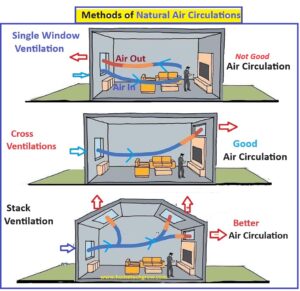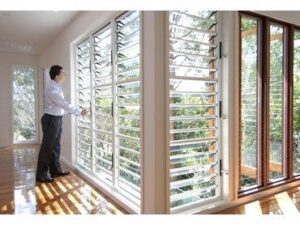
Types of Natural Air Circulations in Homes
- There are several types of natural air circulation strategies that can be utilized in homes to promote airflow and maintain a comfortable indoor environment.
- Here are some common types:
- Cross Ventilation:
- This is one of the most basic and effective methods of natural air circulation.
- It involves opening windows or doors on opposite sides of a room or building to allow fresh outdoor air to enter and stale indoor air to exit.
- Cross ventilation takes advantage of natural wind currents and can be enhanced by positioning openings strategically based on prevailing wind directions.
- Stack Effect Ventilation:
- Also known as chimney effect ventilation, this method relies on the principle that hot air rises and cool air sinks.
- In homes with multiple levels or tall ceilings, warm air naturally rises and escapes through upper openings such as vents, skylights, or high windows.
- This creates a negative pressure zone that draws in cooler air from lower levels or through open windows and doors.
- Windcatchers:
- Common in traditional architecture in arid regions, windcatchers are tall, chimney-like structures with openings at the top and bottom.
- They capture prevailing breezes and direct them downward into the living spaces, creating a cooling effect.
- Windcatchers can be passive (relying solely on wind) or enhanced with fans for increased airflow.
- Ventilation Louvers
- Louvers are angled slats or fins installed in walls, roofs, or windows. They can be adjusted to control the flow of air into or out of a building.
- Louvers are particularly useful for directing breezes into specific areas or rooms, depending on their orientation and adjustability.

Natural Ventilation by Louvers for Natural Ventilations for homes
- Roof Ventilation:
- Roof vents, such as ridge vents, gable vents, or turbine vents, are installed on roofs to allow hot air to escape from the attic or upper levels of a building.
- This helps prevent heat buildup and reduces the need for mechanical cooling. Roof ventilation works in conjunction with lower openings (e.g., windows or vents) to create a natural airflow path.
- Clerestory Windows:
- These are windows installed high on walls, typically above eye level.
- Clerestory windows allow natural light to enter while also promoting air circulation.
- When opened, they can facilitate the escape of warm air and draw in cooler air from lower levels.
- Interior Courtyards:
- In some architectural designs, interior courtyards are used to create a central open space surrounded by living areas.
- This configuration encourages natural ventilation by allowing air to flow through the courtyard and into adjacent rooms, enhancing overall airflow within the home.

